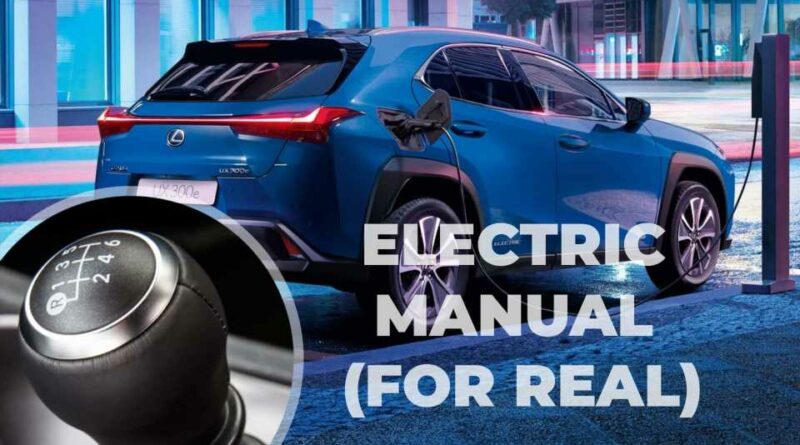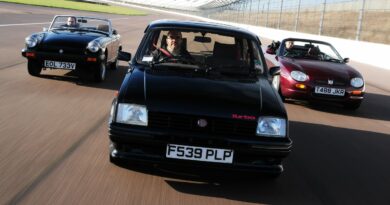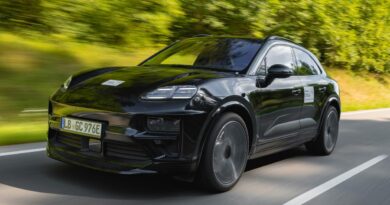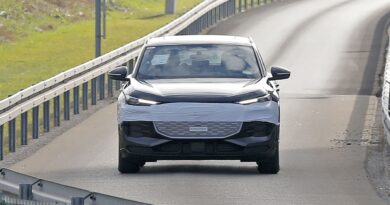Toyota's Manual Transmission For Electric Cars Is Already Amazing
I’m sitting on the tarmac at Toyota’s brand-new Technical Center Shimoyama in a red Lexus UX crossover that has a little something extra no other UX has. It’s a six-speed manual transmission and a third pedal in the footwell. Making this car extra exceptional is the fact that it’s a Lexus UX 300e—an electric vehicle. That’s right: this EV has a manual transmission.
It shouldn’t exist at all. It doesn’t even have a name yet. But it’s definitely confirmed for production, headed to some future Toyota electric vehicle you’ll actually be able to buy in a few years. And it’s so much more fun than I expected it to be.
I wasn’t allowed to take photos, but this past screenshot shows more or less what the interior was like.
In part, I can thank the guy sitting to my left for some of that: Yoichiro Isami, a young Toyota engineer who crafted the patents for this crazy idea. He and his team have spent years developing a system that simulates the way a multi-gear transmission operated with a stick shift and clutch delivers torque from a motor to the wheels—in this case, an electric motor.
“I have always driven manual,” says Isami, who later tells me he’s a GR Yaris driver. “But in this electrified era, I have no vehicle I like. So I made this.”
He later adds with a devilish grin: “With this system, I love BEV,” referring to the common Japanese acronym for a battery-electric vehicle.
What happens when an engineer who’s a GR Yaris guy gets a green light from his company to turn a crazy idea into a skunkworks project, and then something destined for actual, future EVs? I’m about to find out.
Save The Manuals, Electric Edition
The newly rechristened Japan Mobility Show was meant to show the world that that country’s automakers have what it takes to compete in the EV world with a rising China and Korea, both of which have them clearly rattled as they play catch up in the electric arms race. Toyota, specifically, invited journalists from all over the world to see what their R&D departments have been up to: solid-state batteries, new in-car software applications like AI assistants, future EVs with hardware set up to open the door to the “living room on wheels” concept we’ve been promised so long, and much more.
But Toyota’s made a concerted effort to not be so boring over the past few years. And it’s more than fair to say that until fairly recently, the company has been pretty EV-skeptical. I also get the sense that many people within it don’t love the idea that so many EVs drive the same, or that the traditional car enthusiast spirit could get lost in an electric transition. Hence, when Isami and his team cooked up a way to make an EV feel like it’s driving with a stick shift, I get why his higher-ups said “Go nuts.” If this works out, it’s a killer app no other automaker will offer on its EVs. Not yet, anyway.
How Does This Even Work?
Obviously, it’s not a real manual transmission—not the way a gas car has a physical gearbox, clutch, and linkage. It’s not needed here.
Instead, the Toyota team cooked up an independent six-speed stick-shift unit with a sensor attached and a clutch pedal with the same. Those sensors detect the movement of those devices and then use software to artificially modulate the amount of torque the electric motor sends to the wheels.
“We also changed the control program of the electric motor,” another engineer, Tatsuya Iwamura, told us before we went out on the Shimoyama test track. “You will feel like you are driving a car with a manual transmission.”
Coupled with artificial engine noise delivered through the car speakers, it replicates the experience of driving an ICE car in an EV—and it does this so well you might forget what’s under your hood.
Toyota’s been at this for a while; some patents date back to 2017. We first heard real progress on it last year, and now, Toyota’s engineers are making no secret of the fact that it’s going into production. And it won’t be on this UX; this is just a mule for the project. (Of course, they nervously demurred when I asked if it would debut on the production FT-Se, the “electric MR2” everyone loved at the auto show, which I heard from its chief designer.)
Moreover, Toyota is cooking up other ways to make EVs more lively. Before driving the manual UX, I sampled a Lexus RZ with programmable engine sounds and more customized power delivery—basically, an EV that can act and sound like a Toyota Tundra, an economy hatchback, or a Lexus LFA on demand. The engine sound on the latter car needed some work, but it’s a clever idea. Now think downloadable “profiles” for your EV that simulate the gas car of your choice, or even the ability to fully customize how your EV sounds and how it puts down power, almost like in a video game.
Oh, and by the way—that car worked the same way as this simulated manual EV, just with paddle shifters and no clutch.
Skunkworks car engineers. Just the best people.
So Is It Any Good?
Because this was a development vehicle, no photos were allowed, and the only video permitted was Toyota-shot footage of me getting in and out of the car—not exactly the most compelling visuals, I think we’d agree. But the Lexus’ interior was teeming with add-on buttons, stickers, and wires from the development team.
As I line up to enter the track, I intentionally “stall out” the UX to see what it would do. Sure enough, a screen flashes red and I push the clutch to restart the car, just like most modern manual gas cars work. Then I “shift” into “first gear” and press the accelerator, and after that… wow. Just wow.
Gallery: Lexus LF-ZC Concept
This UX mule has a custom six-speed that feels similar to a GR Corolla’s gearbox with tight, short shifts and a deep, vaguely six-cylinder-ish bespoke engine sound they cooked up just for this project. I work my way through the gears just like on a gas car, straining to keep it under 100 kph like the developers asked, because I’m having so much fun and wanted to go fast. But sure enough, the answer is yes—the setup really does feel like a true manual. With my eyes focused on the track ahead and my ears full of whatever that engine was, I momentarily forget I’m in an EV.
The car even jerks back and forth slightly as I change gears, just like a manual gas car might. I’m laughing hysterically the entire time. It even gives me the exact amount of power I’d have in second or third gear, limiting the car’s speeds accordingly. I get it up to fifth before Isami asks me to take it down a peg or two. Every part of this—the shifting, the clutch, the noise, the movement of the car, makes me swear I’m in a gas car. It even “engine brakes” when I downshift and lift off the throttle, and Isami tells me it can double-clutch too, though I don’t get to try this.
Then Isami hits the same switch on the center console and the car goes back to BEV mode, or automatic mode. The engine sounds stop; the power delivery goes back to what I expected. It’s like I wake up and come back to reality, and the Lexus is an EV again.
That may be the best part of all of this: you can turn it on and off whenever you want. No more suffering through stop-and-go traffic with a stick shift. You can have all the backroad fun when you want it, and all the convenience and comfort and quiet of an EV when you want that instead.
Lots Of Questions Remain, But Just Go With It
I only got two brief laps in this manual EV Lexus, but I’m still smiling like Isami when I think about it. But the cynics among us will argue, what’s the point of this? And they’re not entirely wrong. I actually like the ability to have a room-level conversation in an EV, or to hear my music better than I ever could in a car before, or to not mess with shifting in traffic. But on the right road and under the right conditions, I love a good manual transmission.
Plenty of questions remain here. What EVs will Toyota deploy this system for? What drivers would it be for? If the take rate for manuals on gas cars was so low, why would these be any better? What will it cost? Will this have any impact on the EV’s electric motor? And with Toyota and other automakers putting a big emphasis on reducing and downsizing components like HVAC systems to increase interior space, where would a stick even go?
I think there potentially will be a market, in the future, for enthusiasts willing to pay for such features on higher-end cars. It’d be silly to simulate a manual transmission on an economy EV, but if Lexus is really making some kind of quasi-LFA electric supercar, I can see the appeal here.
Plus, it’s just fun. Driving it is fun. The guys behind it clearly had fun; this system obviously comes from a place of genuine, sincere love for the stick shift. And if Elon Musk can be hailed as a comedic genius by the Tesla faithful for making EVs with fart noises, Toyota should get a pass for making one with a six-speed manual transmission. This team reverse-engineered an anachronistic technology for EVs just because they thought it would preserve something they loved about driving. It’s hard for any enthusiast to not appreciate that.
If EVs are the future—and I certainly think they are or I wouldn’t be here—the day may come someday when whole generations of drivers have zero experience with a manual transmission at all. We’re very nearly at that point right now. But until that happens, it’s great to see some folks like Isami and his team thinking outside the box to save the manuals.
Contact the author: patrick.george@insideevs.com
Source: Read Full Article





